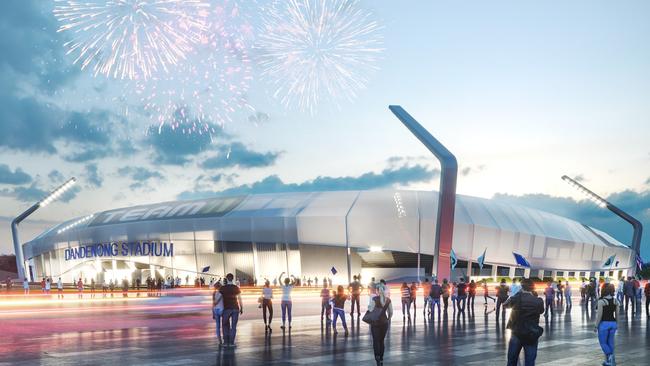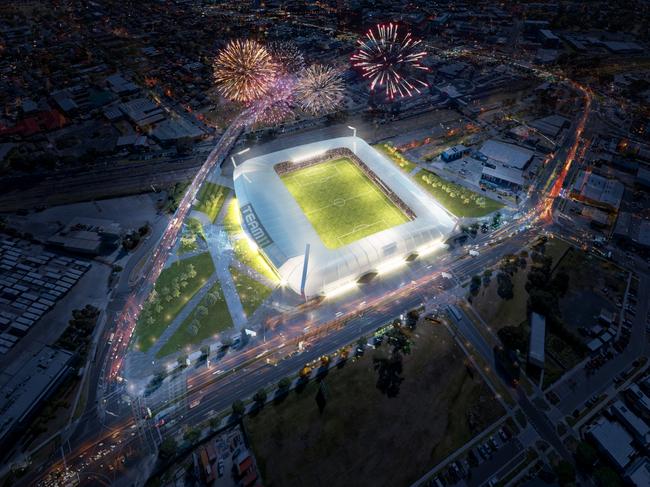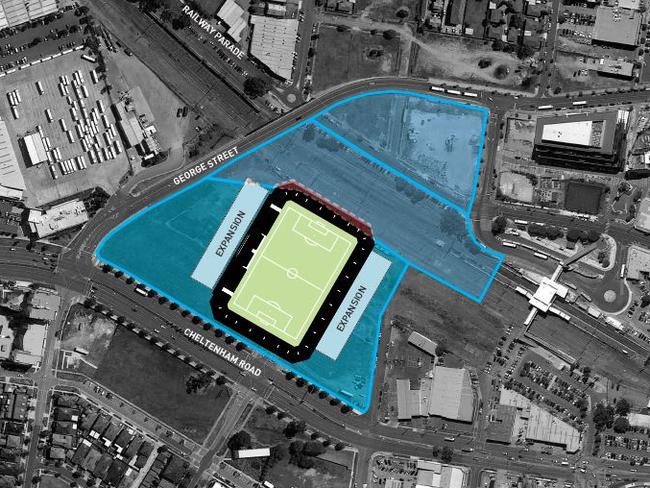Sports, civic leaders launch new push for rectangular stadium at Dandenong
Sporting and civic leaders have drawn up new plans for a rectangular stadium at fast-growing Dandenong, allowing Melbourne’s east to host A-League matches.

Victoria
Don't miss out on the headlines from Victoria. Followed categories will be added to My News.
A major new rectangular stadium should be built in Melbourne’s south east to meet a surge in demand and a gap in the city’s sporting infrastructure.
Sports and civic leaders say a “boutique” new rectangular stadium with up to 20,000 seats built in Dandenong could provide an invaluable asset for the fast growing region.
It could also help Melbourne pitch for more major events, become the new home of an A-League soccer club and host soccer, rugby and rugby league matches and concerts.
Plans for a new Dandenong stadium were pushed as part of a bid for a new A-League soccer team in 2018.
An economic impact study found the stadium would attract about 465,000 people each year, provide significant tourism impacts, 444 ongoing jobs and $114m of annual economic output in southeast Melbourne from increased visitor activity.
While plans for the stadium were put on ice when the A-League licence was instead handed to Western United, on the opposite side of the city, there are calls to bring it back to life.


Football Australia chief executive James Johnson told the Herald Sun the fact Melbourne would soon become the most populated city in Australia, with soccer the top participation sport, strengthened the case.
“This growth will be felt at all levels of the game, where in the not so distance future there will be the need for a multipurpose, boutique sized rectangular stadium for 15,000 patrons,’’ he said.
Mr Johnson said a new stadium would allow the south east to host A-League and A-League Women matches, prestigious international youth tournaments, domestic Cup fixtures, NPL clubs and community and school events.
“Outside of football, such a venue would likely be utilised by other sports and organisations for the same purposes,’’ he said.
A business case for a “Dandenong Sports and Events Centre’’ by Deloitte, the City of Greater Dandenong and Sport and Recreation Victoria was completed in mid-2022.
It proposed stage one of the stadium to seat 15,000 people, rising to 20,000 once fully developed.
The push for a stadium to service one of the fastest growing regions in Australia and a population in excess of 1.5 million people, was backed by Greater Dandenong, City of Casey and Cardinia Shire councils.
It also won the support of surrounding councils in Latrobe, Frankston, Mornington, Knox, Monash, Baw Baw, Wellington, Bass Coast and South Gippsland.

Dandenong City football director Ljuban Palinic said: “To have a purpose built stadium in the heart of Dandenong would be a dream come true for the entire football community.
“It would not only bring football together in the south east but would inspire and motivate our children to believe they can achieve their dreams.
“With so many nationalities in one area coming to support a football team it would unite and bring joy to the community as a whole and that is what football does”.
In a statement, Dandenong Council said: “The business case demonstrated the potential for significant benefits, however further planning and resources are required in order to progress the proposal.’’
The renewed stadium push would be closely watched by Melbourne City, which has set up a training base nearby at Casey Fields in Cranbourne.
Sources said they would be a perfect fit as a tenant club for a new Dandenong stadium and the club’s cashed up parent club Manchester City could help bankroll the project along with state and federal government support.
But Mr Johnson said the stadium “would not replace the need for Melbourne to either build a second rectangular stadium or seek ways to rectangularise the MCG or Marvel Stadium, which most sports require to best support their product and the fan experience.’’
Despite possessing some of the best stadiums in the world, Melbourne does not have a purpose built rectangular stadium capable of seating 40,000 people or more – a key FIFA requirement for cities wanting to stage the biggest sporting event on earth.
“As it stands, venue availability in Melbourne is a real challenge when aligning dates with the international calendar,’’ Mr Johnson said.
“And without a rectangular venue that can accommodate upwards of 40,000 fans, ideally 60,000, Melbourne would miss out of hosting major global football tournaments such as the FIFA Club World Cup and FIFA World Cup.
“Football Australia welcomes the opportunity to work with interested governments on how they could future-proof themselves in terms of participation growth and community demand, while attracting highly desirable football events to Greater Melbourne.”
More than 22,000 soccer players are registered in Melbourne’s south east, which is also one of the state’s most culturally diverse communities.
Greater Dandenong is the most multicultural council in the country, with more than 60 per cent of its population born overseas and 160 nationalities represented.



